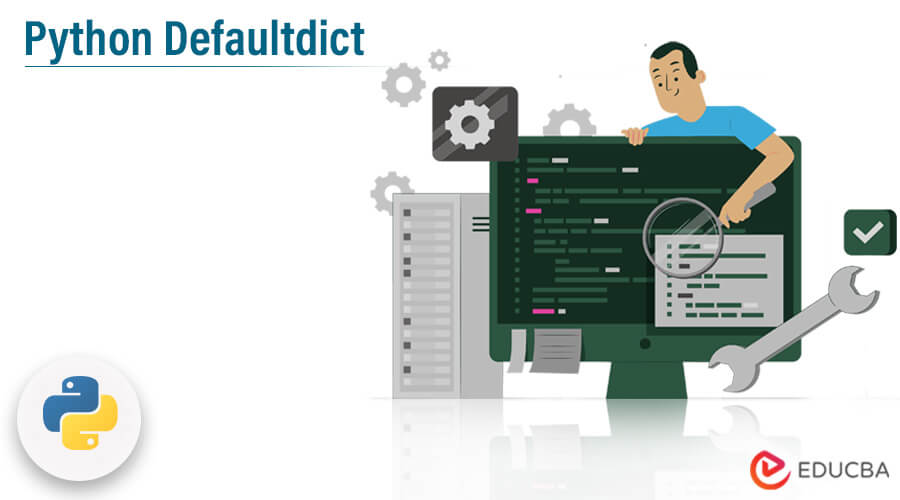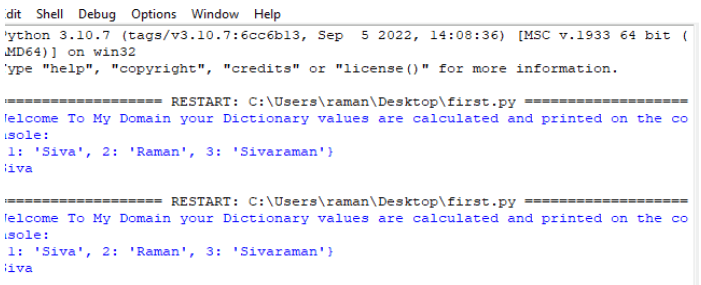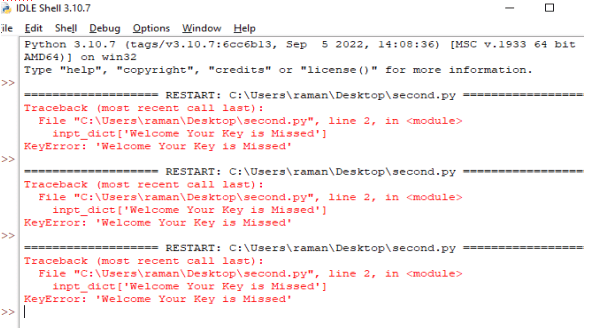Updated February 18, 2023

Introduction to Python Defaultdict
The python defaultdict is one of the types and is known as the dictionary for collecting unordered sets of datas as well as values, which include collections such as maps, lists, and other data types. It can mainly hold data by using key-value pairs; however, the key must be unique and immutable. The python tuple can be measured as the key, whereas the python list cannot place the element.
Key Takeaways
- It’s a regular python dictionary but it’s helpful for accessing the keys.
- It also generates the keys automatically with a default value.
- It handles the missing keys in defaultdict dictionaries.
- In default, there is no parameter passed on the defaultdict() method.
- Mostly it never throws the KeyError.
What is Python Defaultdict?
When we access data using key-value pair formats, if the key is missing, the key is automatically altered. Also, the defaultdict’s main purpose will be to generate the build and default value, but otherwise, the defaultdict will behave more conventionally on the Python dictionary. Finally, missing keys and results may be handled very well with dictionaries. The int datatype indicates the n number of values and is configured in defaultdict.
It should be indicated and the values should be returned as a list type. Defaultdict is a subclass of the dictionary class that returns an object-like dictionary format and allows you to place a sequence of elements with curly braces and other operators like commas, etc.
How to Create Python Defaultdict?
In Python, key-value pairs are stored in containers known as dictionaries. Keys must be distinct and unchangeable until the task is completed. While a Python list cannot be used as a key because it is mutable, a Python tuple can be called and used in the same process.
Steps to Create Python defaultdict:
1. Download and install python on the machine. Here I have already installed it.
2. Next I opened python IDLE and entered the below python code.
Code:
Dict = {1: 'Siva', 2: 'Raman', 3: 'Sivaraman'}
print("Welcome To My Domain your Dictionary values are calculated and printed on the console:")
print(Dict)
print(Dict[1])3. And save the same with .py extension.
4. Then finally I executed the above code by using the Run command as shown in the below output.
The above steps are the basics of creating a defaultdict in Python. Using python defaultdict, the type is set and the default factory is allocated as list format, which builds the data dictionary and maps the keys to list format.
Using Python defaultdict Type
It has n number of types for utilizing the defaultdict on the python. Some of the types are as follows:
1. Using list as the default factory for grouping items
The default factory function for the class list, as specified in the first set of parameters, must be called when the defaultdict is created, along with the list type of values. The callable should not be used or triggered while it is initialized as the valid set of objects that should be passed. Because the first set of parameters is either null or callable, the operator and other parentheses are more frequently used with type errors. To access the keys, the result call is converted to the list() method, which has an empty set of values by default. As a result, the defaultdict will include an empty set of list values for adding new keys and references to the list.
2. Number of Items
The defaultdict can be used to count the number of items in a sequence step or followed by data types. The collection type of argument help in finding the data dictionary by counting the parameters that were passed as inputs to the method. In the default method, int(), with separate types of arguments, returned a value of 0. Python dictionary containing collection classes for declaring and specifying the counter method.
Python Defaultdict Handle Missing Keys
The missing keys is one of the issues for using the python dictionaries and deal with the frequent key error and frustrating the codes that make it more complex. To create dictionaries that rely on extensive codes for handling the frequent amount of datas. We can handle the python dictionaries for missing the keys for different method types.
1. Setdefault()
It is one of the types which mainly configured to the python document and set the data dictionary to return the value.
Example:
Code:
inpt_dict = {}
inpt_dict['Welcome Your Key is Missed']
inpt_dict.setdefault('Welcome Your Key is Missed', 'Entered default value')
inpt_dict['Welcome Your Key is Missed']
inpt_dict.setdefault('Welcome Your Key is Missed', 'Entered default value')
inpt_dictOutput:
The above code is an example of setdefault() method to identify the keys.
2. get() method usage
The python defaultdict get() method is to retrieve the datas which satisfied the conditions like if and else. When the condition is true and it returns the value as 0 and if the condition is failed or false then it throws KeyError.
Example:
Code:
inpt_dict = {}
inpt_dict.get('Welcome Your Key is Missed', 'Entered default value')
inpt_dictOutput:
3. Python defaultdict List
In defaultdict() function, the list is the feature, and also we can pass it as the parameter to perform the operations. We can also pass the list as a parameter without the quotes so that the defaultdict() function will group the datas as a dictionary and as well as list format. Before that it shows as key-value pair format after using the list it changed to list type.
Example:
Code:
from collections import defaultdict
res= defaultdict(list)
for i in range(6):
res[i].append(i)
print(res)Output:
The above example shows the list collection in defaultdict() method and it validates the user inputs based on the conditions.
FAQ
Given below are the FAQs mentioned:
Q1. What is defaultdict?
Answer:
It’s a method that is similar behavior of the python dictionary, and it generates the keys and values automatically.
Q2. How to use the defaultdict?
Answer:
While initializing there is no parameter for this function, and it has a default key. It does not throw any KeyError.
Q3. Mention the types of defaultdict.
Answer:
- Lists
- String
- Tuples
- Sets
- Arrays
- Dictionary
Conclusion
It’s a standard behavior like a dictionary which is more helpful to store and retrieve data. The straightforward approach is used to allow the default value in a specific manner while we are uninitialized the keys so that it enables the interpreter for informing the user of inputs in the operations under a specific set of class values.
Recommended Articles
This is a guide to Python Defaultdict. Here we discuss the introduction, how to create python defaultdict? handle missing keys and FAQ. You may also have a look at the following articles to learn more –







